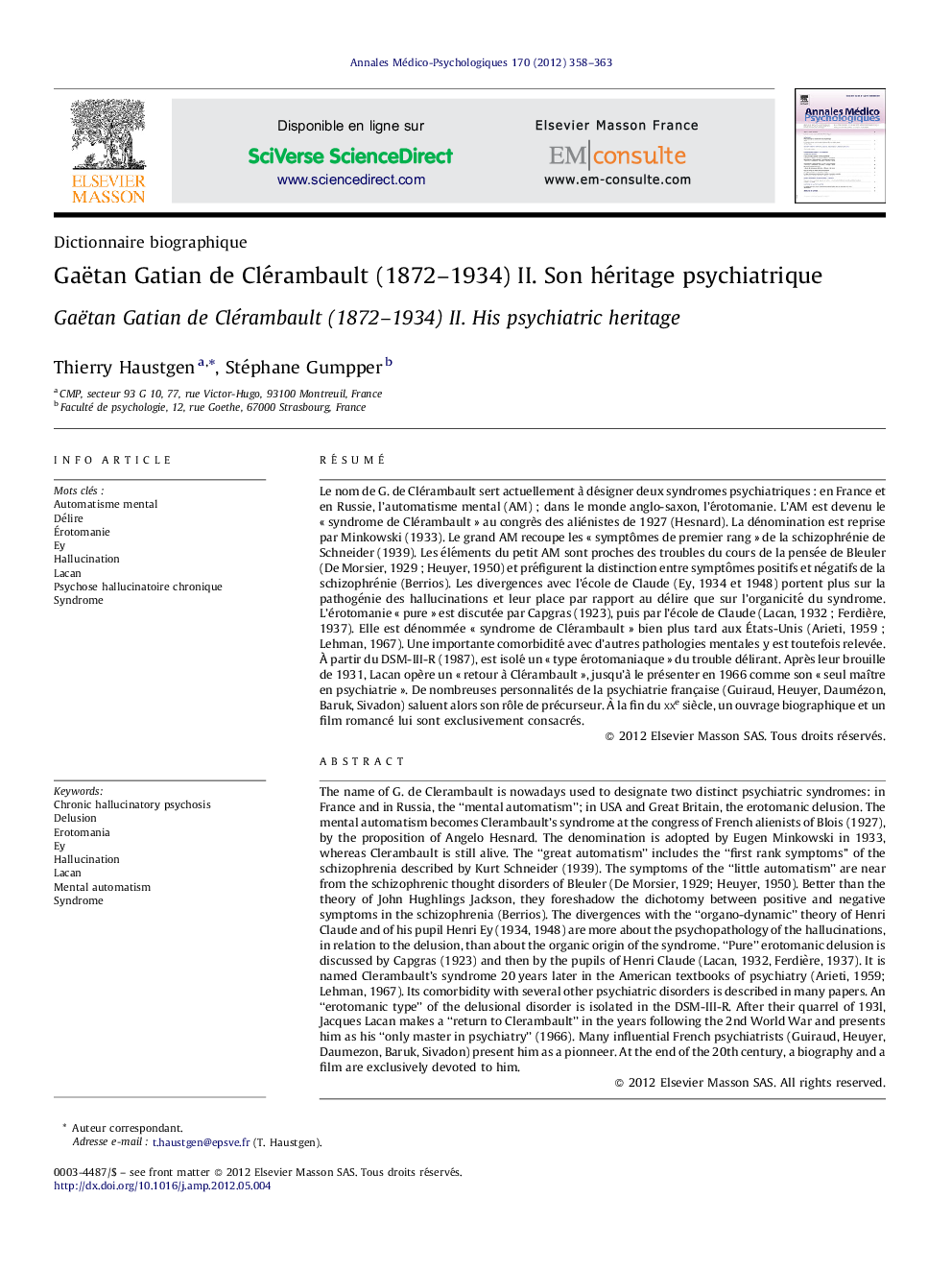| Article ID | Journal | Published Year | Pages | File Type |
|---|---|---|---|---|
| 312622 | Annales Mdico-psychologiques, revue psychiatrique | 2012 | 6 Pages |
RésuméLe nom de G. de Clérambault sert actuellement à désigner deux syndromes psychiatriques : en France et en Russie, l’automatisme mental (AM) ; dans le monde anglo-saxon, l’érotomanie. L’AM est devenu le « syndrome de Clérambault » au congrès des aliénistes de 1927 (Hesnard). La dénomination est reprise par Minkowski (1933). Le grand AM recoupe les « symptômes de premier rang » de la schizophrénie de Schneider (1939). Les éléments du petit AM sont proches des troubles du cours de la pensée de Bleuler (De Morsier, 1929 ; Heuyer, 1950) et préfigurent la distinction entre symptômes positifs et négatifs de la schizophrénie (Berrios). Les divergences avec l’école de Claude (Ey, 1934 et 1948) portent plus sur la pathogénie des hallucinations et leur place par rapport au délire que sur l’organicité du syndrome. L’érotomanie « pure » est discutée par Capgras (1923), puis par l’école de Claude (Lacan, 1932 ; Ferdière, 1937). Elle est dénommée « syndrome de Clérambault » bien plus tard aux États-Unis (Arieti, 1959 ; Lehman, 1967). Une importante comorbidité avec d’autres pathologies mentales y est toutefois relevée. À partir du DSM-III-R (1987), est isolé un « type érotomaniaque » du trouble délirant. Après leur brouille de 1931, Lacan opère un « retour à Clérambault », jusqu’à le présenter en 1966 comme son « seul maître en psychiatrie ». De nombreuses personnalités de la psychiatrie française (Guiraud, Heuyer, Daumézon, Baruk, Sivadon) saluent alors son rôle de précurseur. À la fin du xxe siècle, un ouvrage biographique et un film romancé lui sont exclusivement consacrés.
The name of G. de Clerambault is nowadays used to designate two distinct psychiatric syndromes: in France and in Russia, the “mental automatism”; in USA and Great Britain, the erotomanic delusion. The mental automatism becomes Clerambault's syndrome at the congress of French alienists of Blois (1927), by the proposition of Angelo Hesnard. The denomination is adopted by Eugen Minkowski in 1933, whereas Clerambault is still alive. The “great automatism” includes the “first rank symptoms” of the schizophrenia described by Kurt Schneider (1939). The symptoms of the “little automatism” are near from the schizophrenic thought disorders of Bleuler (De Morsier, 1929; Heuyer, 1950). Better than the theory of John Hughlings Jackson, they foreshadow the dichotomy between positive and negative symptoms in the schizophrenia (Berrios). The divergences with the “organo-dynamic” theory of Henri Claude and of his pupil Henri Ey (1934, 1948) are more about the psychopathology of the hallucinations, in relation to the delusion, than about the organic origin of the syndrome. “Pure” erotomanic delusion is discussed by Capgras (1923) and then by the pupils of Henri Claude (Lacan, 1932, Ferdière, 1937). It is named Clerambault's syndrome 20 years later in the American textbooks of psychiatry (Arieti, 1959; Lehman, 1967). Its comorbidity with several other psychiatric disorders is described in many papers. An “erotomanic type” of the delusional disorder is isolated in the DSM-III-R. After their quarrel of 193l, Jacques Lacan makes a “return to Clerambault” in the years following the 2nd World War and presents him as his “only master in psychiatry” (1966). Many influential French psychiatrists (Guiraud, Heuyer, Daumezon, Baruk, Sivadon) present him as a pionneer. At the end of the 20th century, a biography and a film are exclusively devoted to him.
